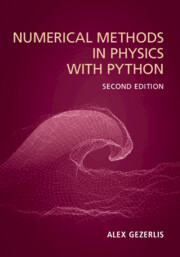
-
Select format
-
- Publisher:
- Cambridge University Press
- Publication date:
- 30 August 2023
- 20 July 2023
- ISBN:
- 9781009303897
- 9781009303859
- 9781009303866
- Dimensions:
- (254 x 178 mm)
- Weight & Pages:
- 1.48kg, 706 Pages
- Dimensions:
- (254 x 178 mm)
- Weight & Pages:
- 1.316kg, 706 Pages
You may already have access via personal or institutional login
Book description
Bringing together idiomatic Python programming, foundational numerical methods, and physics applications, this is an ideal standalone textbook for courses on computational physics. All the frequently used numerical methods in physics are explained, including foundational techniques and hidden gems on topics such as linear algebra, differential equations, root-finding, interpolation, and integration. The second edition of this introductory book features several new codes and 140 new problems (many on physics applications), as well as new sections on the singular-value decomposition, derivative-free optimization, Bayesian linear regression, neural networks, and partial differential equations. The last section in each chapter is an in-depth project, tackling physics problems that cannot be solved without the use of a computer. Written primarily for students studying computational physics, this textbook brings the non-specialist quickly up to speed with Python before looking in detail at the numerical methods often used in the subject.
Reviews
‘A fantastic addition as an introductory textbook for computational physics. The book is timely, and the author made thoughtful and, in my view, many wise choices. The book is comprehensive and yet accessible to undergraduate students.’
Shiwei Zhang - the Flatiron Institute and the College of William & Mary
‘Gezerlis’ book Numerical Methods in Physics with Python is a beautiful example of how an established subject can be brought to the next level by making it very accessible and by introducing several insightful and interdisciplinary applications. This second edition considerably extends the set of exercises, resulting in an extremely useful resource for both students and teachers. Strongly recommended!’
Sonia Bacca - Johannes Gutenberg-Universität Mainz
‘This new edition of Numerical Methods… is another great example of Gezerlis' passion for teaching and for doing so carefully and precisely. Especially welcome, in my view, are the addition of problems at the end of each chapter and the discussion of singular value decomposition (SVD) and Bayesian methods. The SVD is one of the crown jewels of linear algebra which modern students interested in machine learning will surely find beneficial. To physics, computer science, or engineering students mesmerized by the fast Fourier transform, Gezerlis' excellent explanation of it in Chapter 6 is likely to shed some light on the underlying divide-and-conquer algorithm, which is an essential classic.’
Joaquin Drut - University of North Carolina at Chapel Hill
Praise for the first edition:‘I enthusiastically recommend Numerical Methods in Physics with Python by Professor Gezerlis to any advanced undergraduate or graduate student who would like to acquire a solid understanding of the basic numerical methods used in physics. The methods are demonstrated with Python, a relatively compact, accessible computer language, allowing the reader to focus on understanding how the methods work rather than on how to program them. Each chapter offers a self-contained, clear, and engaging presentation of the relevant numerical methods, and captivates the reader with well-motivated physics examples and interesting physics projects. Written by a leading expert in computational physics, this outstanding textbook is unique in that it focuses on teaching basic numerical methods while also including a number of modern numerical techniques that are usually not covered in computational physics textbooks.’
Yoram Alhassid - Yale University
‘In Numerical Methods in Physics with Python by Gezerlis, one finds a resource that has been sorely missing! As the usage of Python has become widespread, it is too often the case that students take libraries, functions, and codes and apply them without a solid understanding of what is truly being done 'under the hood' and why. Gezerlis' book fills this gap with clarity and rigor by covering a broad number of topics relevant for physics, describing the underlying techniques, and implementing them in detail. It should be an important resource for anyone applying numerical techniques to study physics.’
Luis Lehner - Perimeter Institute for Theoretical Physics
‘Gezerlis’ text takes a venerable subject - numerical techniques in physics - and brings it up to date and makes it accessible to modern undergraduate curricula through a popular, open-source programming language. Although the focus remains squarely on numerical techniques, each new lesson is motivated by topics commonly encountered in physics and concludes with a practical hands-on project to help cement the students' understanding. The net result is a textbook which fills an important and unique niche in pedagogy and scope, as well as a valuable reference for advanced students and practicing scientists.’
Brian Metzger - Columbia University
‘… an excellent example of a textbook built on long and established teaching experience … the author has successfully achieved his goals: [this] is an interesting book that has its main appeal in the wealth of examples, the projects proposed, and the Python codes. … a very useful and interesting book that I will certainly include in the material I use for my lectures on numerical methods.’
Gabriele Ciaramella Source: SIAM Review
Contents
-
1 - Idiomatic Python
pp 1-30 -
-
- You have access
- Export citation
-
Metrics
Altmetric attention score
Full text views
Full text views help Loading metrics...
Loading metrics...
* Views captured on Cambridge Core between #date#. This data will be updated every 24 hours.
Usage data cannot currently be displayed.
Accessibility standard: Unknown
Why this information is here
This section outlines the accessibility features of this content - including support for screen readers, full keyboard navigation and high-contrast display options. This may not be relevant for you.
Accessibility Information
Accessibility compliance for the PDF of this book is currently unknown and may be updated in the future.


